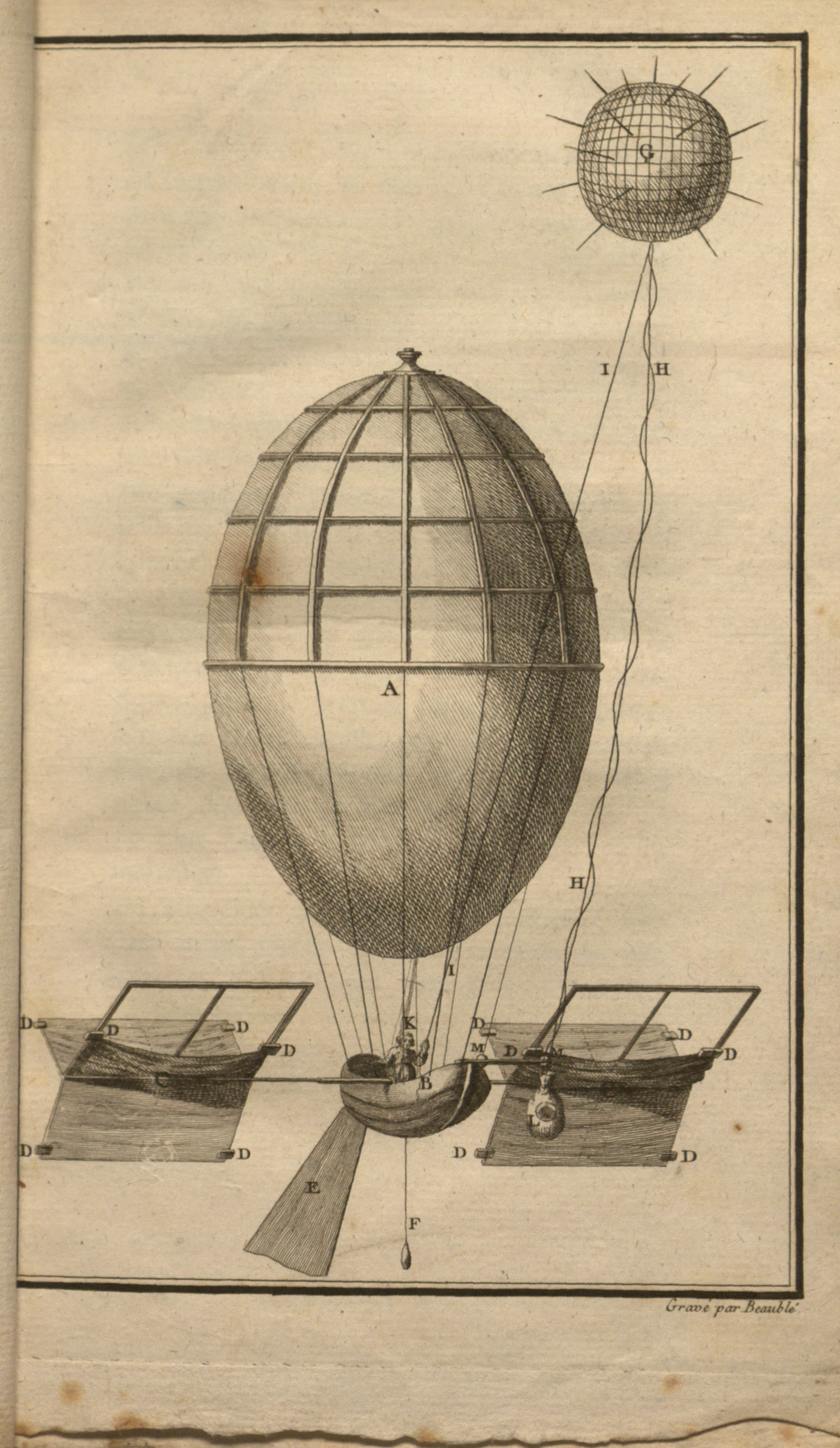Creation Date
14 January 1784
Medium
Genre
Description
This image highlights the efforts of early experimenters to find ways to develop balloons that could be steered through the air as part of a concerted effort to demonstrate the usefulness of balloons. It offered readers a glimpse of new ideas about balloon navigation using a rudder and paddle-wheels.
This image, like Cavallo’s image of the process for inflating hot air balloons, was a popular element of accounts of balloon in late eighteenth-century print culture. Its focus on the means by which balloons might be steered responded to one of the leading objections to the balloonomania: the question of how they could possibly be of any use, given that they were at the mercy of the winds once they ascended. Cavallo’s The History and Practice of Aerostation (1785) confidently suggested that aerial navigation, “far from being complicated or troublesome, is perhaps as simple as might have been wished by the warmest imagination; and so easy for the aeronaut, that he has absolutely much less trouble with the machine, than a sailor with a ship in the most favourable circumstances.” Anticipating the objection that “those machines cannot be guided against the wind, or in every direction at pleasure,” Cavallo offered the parallel of sailing vessels’ ability to steer upwind."
The fascination with ballooning had been triggered by the efforts of the Montgolfier brothers in France. In June 1783, they bhad launched the first ever flight, carrying a sheep, a cock, and a duck, in front of 60,000 spectators and the Royal Family. On October 15, 1783, they launched the first ever human flight, this time in front of 100, 000 spectators and the Royal family. Numerous flights soon followed, both in France, England, and elsewhere.
Early aeronauts tried to respond to this challenge in two ways. On the one hand, many early balloons included a rudder and oars (much wider than the oars used in boats today) intended to enable the aeronaut to steer the balloon through the skies. On the other hand, anticipating the aircraft design that would one day follow, some participants in these debates argued that the balloons (and the baskets underneath them) should be shaped in an oblong manner, like a fish or (as one publication suggested) a bird. The image shown here retains the standard shape of the balloon but includes both a rudder and the equivalent of paddlewheels, which could be operated from the carriage.
Some critics, anticipating similar debates today, rejected the idea that ballooning must be proven to be useful in any sort of practical way. “What is the use of a new-born child,” Benjamin Franklin famously responded when asked about ballooning’s utility. It was enough, they insisted, that it be embraced as an exciting example of the fruits of curiosity-driven research without demanding that it be translated into applied knowledge. But for those who felt the need to respond to this challenge to demonstrate ballooning’s usefulness, devices for steering them remained a crucial and intriguing element of the technological challenge.
Locations Description
The Montgolfiers launched their first balloons at Varsailles; Vincento Lunardi ascended from London. By its nature, however, balloon flights soon proliferated across both countries, as well as much of Europe and America.
Additional Information
Bibliography
Baldwin, Thomas. Airopaida. London: J. Fletcher, 1786.
Burke, Edmund. “Enquiry into the Sublime and Beautiful,” The Norton Anthology of Theory and Criticism, Ed. Leitch, Vincent, B. New York and London: W. W. Norton & Company, 2001.
Cavallo, Tiberius. The History and Practice of Aerostation. London : printed for the author, and sold by C. Dilly; P. Elmsly; and J. Stockdale, 1785.
Cosgrove, Denis. Apollo’s Eye: A Cartographic Genealogy of the Earth in the Western Imagination. JHU Press, 2001
Cruikshank, George. George Cruikshank’s Table Book, Abbot Beckett, Editor. London: Punch Office, 1845.
De Bolla, Peter. The Education of the Eye: Painting, Landscape, and Architecture in Eighteenth-Century Britain. Stanford, CA: Stanford University Press, 2003.
Harley, J.B. The New Nature of Maps: Essays in the History of Cartography. Baltimore and London: The Johns Hopkins University Press, 2001.
Holmes, Richard. The Age of Wonder: How the Romantic Generation Discovered the Beauty and Terror of Science. UK: Harper Collins, 2008.
Illustrations of Natural Philosophy. London: Reynolds. 1850.
Keats, John. Complete Poems. Stillinger, Jack, Ed. Cambridge, MA and London, England: The Belknap Press of Harvard University Press, 1982.
Keen, Paul. “The ‘Balloonomania’: Science and Spectacle in 1780s England,” Eighteenth-Century Studies - Volume 39, Number 4, Summer 2006, pp. 507- 535
Oxford Dictionary of National Biography. Oxford University Press. 2004-9. (http://www.oxforddnb.com.ezproxy.library.wisc.edu/view/article/18434)
Oxford Dictionary of National Biography. Oxford University Press. 2004-9.(http://www.oxforddnb.com.ezproxy.library.wisc.edu/view/article/11379?docPos=15)
Stewart, Susan. On Longing. Durham and London: Duke University Press, 1993.
The Busy Body; A Collection of Periodical Essays, No. 15 (3 February 1787) - No. 25. London: C. Stalker, 1787.
The Juvenile Library, Vol. 2. London, 1800-01. Eighteenth Century Collections Online. Gale. University of Wisconsin - Madison. 12 May 2009
The Juvenile Library, Vol. 3. London 1800-01. Eighteenth Century Collections Online. Gale. University of Wisconsin - Madison. 12 May 2009
The London Packet ; Or, New Lloyd’s Evening Post, Issue 2310. London, 1785.
The New Spectator with the Sage Opinions of John Bull, No. 1 (3 February 1784) - No. 25 (17 January 1786) London: T. Rickaby.
Wakefield, Priscilla. Mental improvement: or, the beauties and wonders of nature and art. In a series of instructive conversations. Dublin: 1800.
Wolf, Norbert. Romanticism. Koln: Tanshen, 2007.

